Wicker railway station was the first railway station to be built in Sheffield, England. It was to the north of the city centre, at the northern end of the Wicker, in the fork formed by Spital Hill and Savile Street. It was opened on 31 October 1838 as the southern terminus of the Sheffield and Rotherham Railway, which ran north to Rotherham Westgate railway station.

Derby railway station is a main line railway station serving the city of Derby in Derbyshire, England. Owned by Network Rail and managed by East Midlands Railway, the station is also used by CrossCountry services and two daily Northern services.
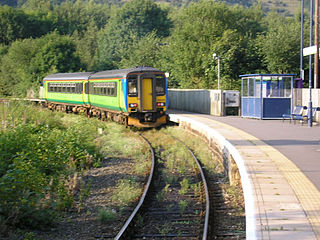
Ambergate railway station is a railway station owned by Network Rail and managed by East Midlands Railway. It serves the village of Ambergate in Derbyshire, England. The station is located on the Derwent Valley Line from Derby to Matlock, which diverges from the Midland Main Line just south of the station at Ambergate Junction.

The North Midland Railway was a British railway company, which opened its line from Derby to Rotherham (Masbrough) and Leeds in 1840.
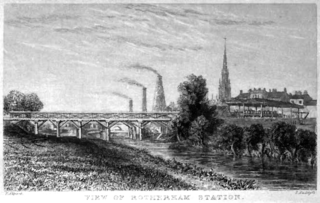
The Sheffield and Rotherham Railway was a short railway in England, between Sheffield and Rotherham and the first in the two towns.

Rotherham Central railway station is in Rotherham, South Yorkshire, England. The station was originally named "Rotherham", becoming "Rotherham and Masborough" in January 1889 and finally "Rotherham Central" on 25 September 1950.

Swinton railway station is a railway station in Swinton, South Yorkshire, England. It has three platforms and a small bus station, and lies at the junction of the former North Midland Railway main line between Rotherham Masborough and Leeds via Cudworth and the former South Yorkshire Railway line to Doncaster.

Rotherham Masborough railway station was the main railway station for Rotherham, South Yorkshire, England from the 1840s until 1987, when most trains were rerouted via Rotherham Central. It had four platforms, with a large sandstone station building on the eastern Platform Four, large iron and glass platform canopies, a fully enclosed footbridge and wooden waiting rooms on the other platforms. It closed in 1988, except for a few football specials.
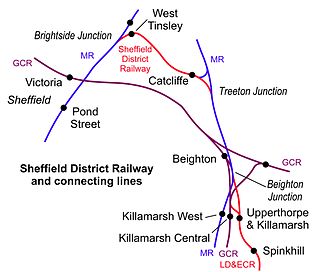
West Tinsley railway station is a former railway station in Sheffield, South Yorkshire, England.
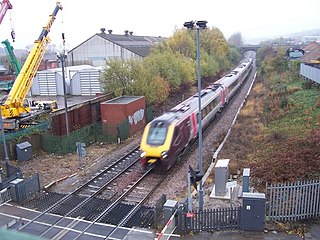
Holmes railway station was a railway station in Rotherham, South Yorkshire, England. The station served the communities of Masbrough and Holmes and was situated on the former Sheffield and Rotherham Railway (S&R) line between Rotherham Westgate Station and Wincobank and Meadowhall Station. The station, which had two flanking platforms, opened with the line.
The Sheffield District Rail Rationalisation Plan was a series of linked railway civil engineering projects, station and line closures and train route changes that took place in and around Sheffield, South Yorkshire. The majority of these changes took place in the 1960s and early 1970s, however the plan, by now much modified in the face of rapidly dwindling freight traffic, was not fully realised until the 1980s.
The South Yorkshire Railway was a railway company with lines in the south of the West Riding of Yorkshire, England.
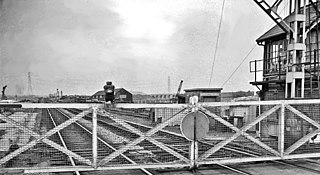
Beighton railway station is a former railway station near the village of Beighton on the border between Derbyshire and South Yorkshire, England.

Woodhouse Mill railway station was opened in 1840 by the North Midland Railway on its line between Rotherham Masborough and Chesterfield.

Treeton railway station is a former railway station in the centre of Treeton, Rotherham, England.

The River Don Navigation was the result of early efforts to make the River Don in South Yorkshire, England, navigable between Fishlake and Sheffield. The Dutch engineer Cornelius Vermuyden had re-routed the mouth of the river in 1626, to improve drainage, and the new works included provision for navigation, but the scheme did not solve the problem of flooding, and the Dutch River was cut in 1635 to link the new channel to Goole. The first Act of Parliament to improve navigation on the river was obtained in 1726, by a group of Cutlers based in Sheffield; the Corporation of Doncaster obtained an Act in the following year for improvements to the lower river. Locks and lock cuts were built, and, by 1751, the river was navigable to Tinsley.

Killamarsh West is a former railway station in Halfway, South Yorkshire, England.
Eckington and Renishaw railway station is a former railway station between Eckington and Renishaw in Derbyshire, England.
Whittington railway station is a former railway station on the southern edge of New Whittington, Derbyshire, England.

Barrow Hill railway station is a former railway station in the village of Barrow Hill in northern Derbyshire, England.















